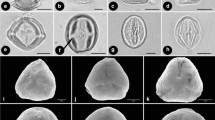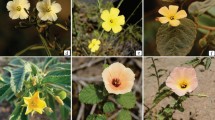Abstract
The pollen morphology of six species ofKeiskea and three representative taxa ofCollinsonia was studied in detail using LM, SEM, and TEM. In both genera, pollen grains are monad, hexa-colpate, and mostly medium in size [P = 28.0 to 37.0 μm, E = 24.3 to 30.7 μm (Keiskea); P = 30.0 to 45.0 μm, E = 26.0 to 39.0 μm (Collinsonia)]. Polar outlines are of circular or ellipsoid form. Shapes range from primarily oblate-spheroidal to prolate-spheroidal to subprolate, and rarely prolate in the equatorial view. Their exine, including the inline characters, are clearly distinct from each other:Keiskea, well-developed bi-reticulate, often forming large lumina by supratectal ridges, unbranched columellae, one-third to one-half of the total exine thickness; versusCollinsonia, mostly perforate without supratectal ridges or a faint/very weak bi-reticulate appearance without supratectal ridges, seemingly branched columellae, ca. two-thirds of the total exine thickness. As demonstrated by these current data, the pollen morphology of the two genera is well distinguished, easily supporting the separation ofKeiskea fromCollinsonia.
Similar content being viewed by others
Literature cited
Abu-Asab MS, Canlino PD (1992) Pollen morphology in subfamily Lamioideae (Labiatae) and its phylogenetic implications,In RM Harley, T Reynolds, eds, Advances in Labiate Science. Royal Botanic Gardens, Kew, pp 97–112
Abu-Asab MS, Canlino PD (1994) Systematic implications of pollen morphology in subfamilies Lamioideae and Pogostemoideae (Labiatae). Ann Missouri Bot Gard81: 653–686
Benlham G (1876) Labiatae,In G Bentham, JD Hooker, eds, Genera Plantarum, Vol 2. Reeve and Co, London, 1160–1223
Briquel J (1895–1897) Labiatae,In A Engler, K Prantl, eds, Die natürlichen Pflanzenfamilien, IV, 3a. W Engelmann, Leipzig, 183–375
Canlino PD, Harley RM, Wagslaff SJ (1992) Genera of Labiatae: Status and classification,in RM Harley, T Reynolds, eds, Advances in Labiate Science. Royal Botanic Gardens, Kew, 511–522
Demissew SD, Harley MM (1992) Trichome, seed surface and pollen characters inStachys (Lamioideae: Labiatae) in tropical Africa,In RM Harley, T Reynolds, eds, Advances in Labiate Science. Royal Botanic Gardens, Kew, 149–166
Erdlman G (1945) Pollen morphology and plant taxonomy. IV Labiatae, Verbenaceae and Avicenniaceae. Svensk Bot Tidskr39: 279–285
ErdLman G (1960) The acetolysis method. A revised description. Svensk Bot Tidskr54: 561–564
Gill LS (1981) Biosystematics of the tribe Satureineae (Labiatae) in Canada 1. Cytologia46: 27–44
Harley MM (1992) The potential value of pollen morphology as an additional taxonomic character in subtribe Ociminae (Ocimeae: Nepetoideae: Labiatae).In RM Harley, T Reynolds, eds, Advances in Labiate Science. Royal Botanic Gardens, Kew, pp 125–138
Harley MM, Palon A, Harley RM, Cade PG (1992) Pollen morphological studies in tribe Ocimeae (Nepetoideae: Labiatae): 1.Ocimum L. Grana31: 161–176
Harley RM, PaLon AJ, Ryding O (2003) New synonymy and taxonomic changes in the Labiatae. Kew Bull58: 485–489
Harley RM, Alkins S, Budanlsev AL, Canlino PD, Conn BJ, Grayer R, Harley MM, De Kok R, KresLovskaja T, Morales R, Palon AJ, Ryding O, Upson T (2004) Labiatae,In JW Kadereit, ed, The Families and Genera of Vascular Plants, VII, Flowering Plants-Dicotyledons, Lamiales, except Acanthaceae including Avicenniaceae. Springer-Verlag, Berlin-Heidelberg, 167–275
Holmgren PK, Holmgren NH, Barnell LC (1990) Index Herbariorum, part 1. The Herbaria of the World, 8th ed, Regnum Vegetabile 120. New York Botanical Garden, New York
Hong S-P, Oh I-C, Ronse De Craene LP (2005) Pollen morphology of the generaPolygonum s. str. andPotygonella (Polygoneae: Polygonaceae). Plant Syst Evol254: 13–30
Huang T-C, Hsieh T-H, Cheng W-T (1998) Keiskea,In Editorial Committee of the Flora of Taiwan, ed. Flora of Taiwan, 2nd ed, Vol 4. National Science Council of the Republic of China, Taipei, 475–477
Jang MY, Heo K (2005) Reproductive morphology ofMegaleranthis saniculifolia Ohwi (RanuncuIaceae) and its systematic implications. J Plant Biol48: 128–135
Keener CS (1979) The chromosomes ofCollinsonia canadensis L. (Labiatae). Sida8: 216
León-Arencibia MC, La-Serna, Ramos IE (1992) Palynological study ofLavandula (sect. Pterostoechas, Labiatae). Canario-maderiense endemics. Grana31: 187–195
Li X, Hedge IC (1994). Lamiaceae,In ZY Wu, PH Raven, eds, Flora of China, Vol 17 (Verbenaceae to Solanaceae). Science Press and Missouri Botanical Garden, Beijing, St. Louis, pp 30–299
Masamune, G (1940) Miscellaneous notes on the flora of the eastern Asia 18. Trans Nat Hist Soc Formosa30: 337–343
Peirson JA, Canlino PD, Ballard HE (2004) Phylogeny of Collinsonia and tribe Elsholtzieae (Lamiaceae) based on ITS sequence analysis. Botany 2004 Electronic Abstract 34, Systematics sections, ASPT (Abstract only)
Peirson JA, Canlino PD, Ballard HE (2006) A taxonomic revision ofCollinsonia (Lamiaceae) based on phonetic analyses of morphological variation. Syst Bot31: 398–409
Pozhidaev AE (1989) Exine structure in pollen grains of the Lamiaceae family. Bot Zhurnal (Moscow, Leningrad)74: 1410–1422 (including 3 plates)
Pozhidaev AE (1992) The origin of three- and six-colpate pollen grains in the Lamiaceae. Grana31: 49–52
Press JR (1982) Taxonomic studies in the Labiatae tribe Pogostemoneae. Bull Brit Mus (Nat Hist), Bot10: 1–89
Punl W, Hoen PP, Blackmore S, Nilsson S, Le Thomas A (2007) Glossary of pollen and spore terminology. Rev Palaeobot Palynol143: 1–81
Ruzin SE (1999) Plant Microtechnique and Microscopy. Oxford University Press, Oxford
Skvarla JJ (1966) Technique of pollen and spore electron microscopy, Part I: Staining, dehydration and embedding. Oklahoma Geol Notes26: 179–186
Trudel MCG, Morion JK (1992) Pollen morphology and taxonomy in North American Labiatae. Can J Bot70: 975–995
Wagslaff SJ (1992) A phylogenetic interpretation of pollen morphology in tribe Mentheae (Labiatae),In RM Harley, T Reynolds, eds. Advances in Labiate Science. Royal Botanic Gardens, Kew, pp 113–124
Wunderlich R (1967) Ein Vorschlag zu einer natürlichen Gliederung der Labiaten auf Grund der Pollenkörner, der Samenentwucklung und des reifen Samens. Oesterr Bot Z114: 383–483
Zhou SL, Pan KY, Hong DY (1997) Pollen and nutlet morphology in Mosla (Labiatae) and their systematic value. Israel J Plant Sci45: 343–350
Author information
Authors and Affiliations
Corresponding author
Rights and permissions
About this article
Cite this article
Hong, SP. Pollen morphology and its systematic implications for the generaKeiskea miq. andCollinsonia L. (Elsholtzieae-Lamiaceae). J. Plant Biol. 50, 533–539 (2007). https://doi.org/10.1007/BF03030706
Received:
Accepted:
Issue Date:
DOI: https://doi.org/10.1007/BF03030706




